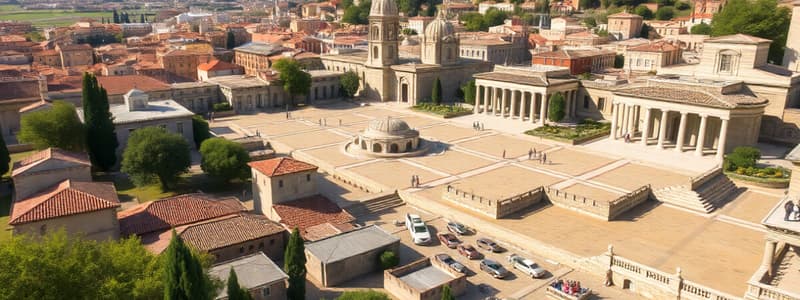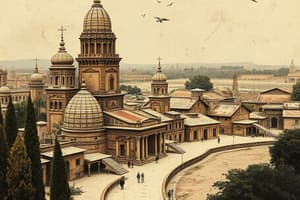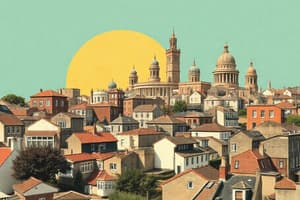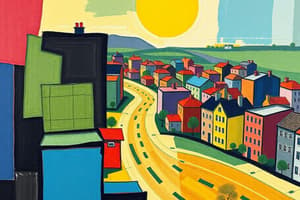Podcast
Questions and Answers
What was a primary function of the Agora in a Greek town?
What was a primary function of the Agora in a Greek town?
- A fortified military headquarters for defending the city-state.
- A gathering place for public events and a market. (correct)
- A residential district exclusively for the wealthy elite.
- An agricultural center focused on crop cultivation and animal husbandry.
In what way did the geographical characteristics of Greece influence the development of its city-states?
In what way did the geographical characteristics of Greece influence the development of its city-states?
- The flat, expansive plains encouraged centralized governance and large-scale agriculture .
- The numerous isolated valleys and islands fostered independent, self-governing entities. (correct)
- The presence of large river systems facilitated trade and communication between distant regions.
- The lack of natural resources prompted aggressive expansion and colonization efforts.
What role were citizens expected to play in the Greek Polis?
What role were citizens expected to play in the Greek Polis?
- Devotion to full-time military service and territorial expansion.
- Active participation in political, economic, spiritual, and social aspects. (correct)
- Strict adherence to the dictates of a ruling aristocratic class.
- Primarily focused on private business ventures and wealth accumulation.
What was the significance of the distance between the Agora and the Acropolis in Greek towns?
What was the significance of the distance between the Agora and the Acropolis in Greek towns?
How did Hippodamus contribute to Greek town planning?
How did Hippodamus contribute to Greek town planning?
What characterized the design and layout of the town of Priene?
What characterized the design and layout of the town of Priene?
What best describes the size and nature of Greek towns?
What best describes the size and nature of Greek towns?
What strategic advantage did Greece's natural barriers and sea provide to its city-states?
What strategic advantage did Greece's natural barriers and sea provide to its city-states?
Which of the following best describes the purpose of Roman aqueducts, considering both practical and symbolic aspects?
Which of the following best describes the purpose of Roman aqueducts, considering both practical and symbolic aspects?
Which characteristic distinguishes Roman urban planning from Greek urban planning?
Which characteristic distinguishes Roman urban planning from Greek urban planning?
How did the design and function of the Colosseum reflect Roman society's values and priorities?
How did the design and function of the Colosseum reflect Roman society's values and priorities?
What does the term 'vomitorium,' in the context of the Colosseum, suggest about Roman social behaviors?
What does the term 'vomitorium,' in the context of the Colosseum, suggest about Roman social behaviors?
What was the primary function of Roman cities outside of the Italian peninsula after 133 BC?
What was the primary function of Roman cities outside of the Italian peninsula after 133 BC?
Considering the combination of practical infrastructure and extravagant displays, how would you characterize Roman civilization's approach to urban development?
Considering the combination of practical infrastructure and extravagant displays, how would you characterize Roman civilization's approach to urban development?
What was the 'castra'?
What was the 'castra'?
How did the quality of life within the city of Rome compare to that in the empire's outer regions?
How did the quality of life within the city of Rome compare to that in the empire's outer regions?
What practical purposes did the grid plan serve in Roman city design?
What practical purposes did the grid plan serve in Roman city design?
Given the information about Roman entertainment, what critical commentary can be made about its effects on society?
Given the information about Roman entertainment, what critical commentary can be made about its effects on society?
In Roman city planning, what was the significance of augury?
In Roman city planning, what was the significance of augury?
What was the function of the Forum in a Roman city, and how did it relate to the Greek Agora?
What was the function of the Forum in a Roman city, and how did it relate to the Greek Agora?
What underlying tension existed within Roman society, as evidenced by their infrastructure and entertainment?
What underlying tension existed within Roman society, as evidenced by their infrastructure and entertainment?
How did the Romans' approach to infrastructure contribute to both the growth and potential decline of their civilization?
How did the Romans' approach to infrastructure contribute to both the growth and potential decline of their civilization?
What key urban design feature was important for the largely pedestrian population in Roman cities?
What key urban design feature was important for the largely pedestrian population in Roman cities?
What does the presence of amphitheaters, theaters, and baths in Roman cities indicate?
What does the presence of amphitheaters, theaters, and baths in Roman cities indicate?
What was a consequence of the intersection of the Cardo and Decumanus?
What was a consequence of the intersection of the Cardo and Decumanus?
What measure did Julius Caesar take to address the problem of traffic and noise in Rome?
What measure did Julius Caesar take to address the problem of traffic and noise in Rome?
Flashcards
Greek Polis
Greek Polis
A self-governing city-state in ancient Greece, where citizens were expected to participate in political life, economic relations, spiritual worship, and social events.
Agora
Agora
A gathering place and market in Greek towns, serving as a center for public events, bordered by temples, workshops, and statues.
Acropolis
Acropolis
An elevated temple district in Greek towns, containing various temples and symbolizing the spiritual center of the polis.
Hippodamus
Hippodamus
Signup and view all the flashcards
Gridded roads
Gridded roads
Signup and view all the flashcards
House blocks
House blocks
Signup and view all the flashcards
Public Buildings
Public Buildings
Signup and view all the flashcards
Shore roads
Shore roads
Signup and view all the flashcards
Roman Characteristics
Roman Characteristics
Signup and view all the flashcards
Roman Economic Support
Roman Economic Support
Signup and view all the flashcards
Castra
Castra
Signup and view all the flashcards
Cardo
Cardo
Signup and view all the flashcards
Decumanus
Decumanus
Signup and view all the flashcards
Forum
Forum
Signup and view all the flashcards
Augury
Augury
Signup and view all the flashcards
Advantages of a Grid Plan
Advantages of a Grid Plan
Signup and view all the flashcards
Forum Functions
Forum Functions
Signup and view all the flashcards
Roman Roads
Roman Roads
Signup and view all the flashcards
"Pax Romana"
"Pax Romana"
Signup and view all the flashcards
Roman "insula"
Roman "insula"
Signup and view all the flashcards
Colosseum
Colosseum
Signup and view all the flashcards
Vomitorium
Vomitorium
Signup and view all the flashcards
Colosseum Subterranean Level
Colosseum Subterranean Level
Signup and view all the flashcards
Roman Aqueducts
Roman Aqueducts
Signup and view all the flashcards
Roman Public Baths
Roman Public Baths
Signup and view all the flashcards
Peristyle
Peristyle
Signup and view all the flashcards
Study Notes
- The Greek and Roman empires significantly impacted town planning, with distinct approaches.
The Greek World
- Greek civilization flourished in the Mediterranean Basin, giving rise to the Greek Polis, a self-governing city-state.
- Each citizen was expected to participate in the polis' political life, economic relations, spiritual worship, and social events.
- Greek cities were small, designed for a human scale; Plato suggested an ideal city size of 5,000 citizens.
- Athens, at its peak, had just over 100,000 citizens.
- Site and culture played crucial roles; absence of floods, diverse resources (fish, grain, grapes, olives, etc.), isolated valleys & islands contributed to their development.
- Isolation provided security, and power was exerted in a less aggressive manner.
- Greek towns featured natural borders; parts were planned geometrically, others for defense.
- They valued democracy and included buildings for both the poor and the rich, as well as public baths.
Agora and Acropolis
- The agora served as a gathering place, market, and venue for public events.
- It was located near the harbor, in the center of the city, and included assembly, council, and chamber halls.
- Temples, workshops, vendors' stalls, and statues bordered the agora.
- The Acropolis was an elevated temple district containing various temples.
- Its architectural vocabulary influenced buildings like banks and town halls well into the 20th century.
- Processions to the Acropolis celebrated the polis.
- The distance between the agora and the acropolis indicated a separation of church and state.
Hippodamus
- Hippodamus was the first Greek architect.
- He designed Piraeus with gridded roads and rectangular house blocks.
- Main roads ran parallel to the shore, and the town outline wasn't necessarily rectangular.
- The city of Priene housed 400 dwellings for a population of 4,000.
- Its agora was surrounded by public buildings and residential blocks containing 4-5 houses each.
- Roads varied in width, with broad roads approximately 23 ft wide, and narrow roads 10 ft wide.
Roman Empire
- Romans had an inclination towards violence, exploitation, and excessive consumption.
- Their achievements display both excess and considerable engineering skill.
- Rome was supported by forced tribute and taxes.
- After conquering Greece by 133 BC, they adopted many Greek urban design concepts.
- Theaters, amphitheaters, and temples (built on the Greek model) with colonnades became prominent.
- The agora was appropriated and transformed into the forum.
- Cities became instruments of empire; Romans expanded beyond the Italian peninsula by 133 BC.
- They planted colonial cities to administer conquered lands, with the "castra" or army camp, a walled grid plan, as a model.
- The empire reached its maximum extent by 211 AD, collapsing after 250 AD.
Roman Cities
- Roman cities were established in invaded areas, which helped maintain agriculture.
- Agricultural land was divided into rectangular parcels.
- A grid pattern was used for most Roman cities, dividing the city into neighborhoods with their own centers.
- Two major intersected roads were the Cardo (North-South) and Decumanus (East-West).
- The Forum, the central public space, was located at their intersection.
- Romans maintained mystical views of the city, practicing augury to determine good locations using animal entrails for signs.
- A priest would plow the city's outline to ritually mark it off from the wilderness.
- The grid plan served practical purposes as it was easy to lay out, administer, defend, and allowed for natural ventilation.
- Pompeii demonstrates that the grid plan was an ideal rather than a strict rule.
Roman Forum
- The Roman Forum was their version of the agora.
- (This example is from Pompeii, preserved by volcanic ash from Mt. Vesuvius in the 1st century BC.)
- It was bordered by temples, offices, jails, and butcher shops.
- Public processions and ceremonies occurred there.
- The surrounding colonnade was a key urban design feature for pedestrians.
Roman Amenities
- Amphitheaters and Baths were important "furnishings" for a Roman city.
- Artifacts found in Pompeii suggest attention & care given to handicrafts demonstrating the importance of food storage. were important.
- When it came to roads, the Romans excelled in highway construction over urban street design.
- The intersection of the Cardo and Decumanus caused traffic congestion.
- Julius Caesar banned wheeled traffic during daylight hours due to noise.
Roman Civilization
- The "Pax Romana" (Roman peace) was a form of civilization, despite the aggressive, exploitative nature.
- Roman "insula" (apartment buildings) were prone to fire and collapse, lacking air conditioning, plumbing, or heating.
- Sewers were often open-air and not connected to upper floors.
- Colosseum held 60,000-90,000 spectators dwarfing the Circus Maximus.
- Over a mile of plumbing pipes supplied public drinking fountains and lavatories.
- It was used for naval & gladiatorial competitions, and later as living and grazing space, and even a fortress in the Middle Ages.
- Mass slaughter was a form of entertainment, with thousands of human and animal lives taken in one "game" day.
- "Performers" included Christians, lions, gladiators, exotic wild animals, captives and prisoners, and their bodies were dumped in pits outside the city.
- By the empire's end, there were 175 game days per year.
- People exited the Colosseum through the "vomitorium."
- The subterranean level held persons and animals prior to use in "contests" and spectacles.
Roman Practicality
- The Roman aqueducts may remind us of our own reservoirs and pipelines.
- Carefully designed streets and road networks remind us of paved roads, freeways and sidewalks.
- the use of street grids may remind us of our own urban landscapes
Roman Shortcomings
- A passion for size and excess led to unsustainable consumption and territorial expansion.
- Aqueducts demonstrated imperial power as much as they provided access to water.
- The city of Rome had 1352 fountains and 967 free baths.
- Romans indulged in public bathing: hot, cold, and lukewarm pools, massage, exercise, and reading rooms.
- A courtyard surrounded by a colonnade or portico (peristyle) was common.
- Life outside Rome was better as the empire's unsustainable and unjust behavior was less visible.
Studying That Suits You
Use AI to generate personalized quizzes and flashcards to suit your learning preferences.




